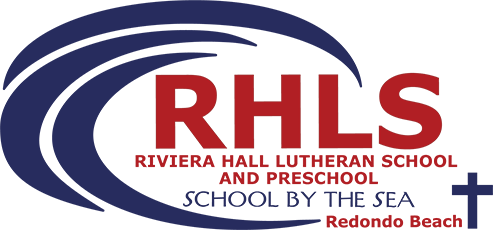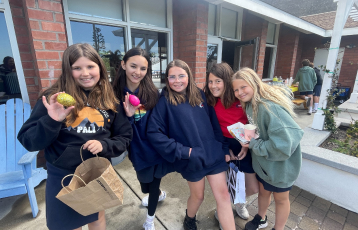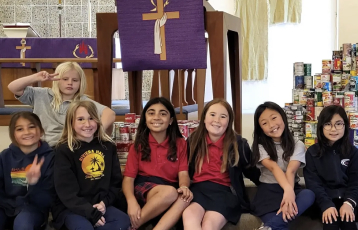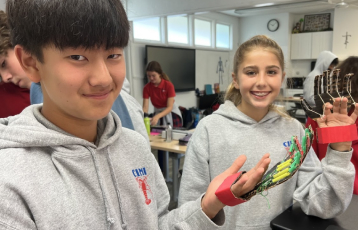Middle School
In grades 6th-8th we carefully balance your child’s intellectual preparation, with social and emotional development—because we’ve seen, year after year, how each aspect supports and enhances the other.
That combination proves even more essential during the transformative Middle School years, as your child grows into a teenager, and academic and personal choices take on greater significance. We’ve created a comprehensive program that cultivates excitement, energy, and possibilities of this pivotal time—fully preparing your child for high school while guiding your whole family through the high school admissions process.
Whether debating a political issue in the classroom, portraying a character on stage, running for Student Senate, competing on a soccer team, or serving breakfast at a soup kitchen, RHLS Middle Schoolers are laying the academic, social, and emotional foundation for their future. Guided and inspired by dedicated faculty members, students stretch and grow beyond their highest expectations into lifelong learners. They do original research, enhancing their critical and analytical abilities; create real-world, technologically sophisticated solutions through design thinking; and deepen their collaborative skills with group projects. Students gain confidence and maturity through service, build resilience by experiencing failure as well as success, learn the value of friendship and sportsmanship—and the lesson that you don’t always need to be out in front to lead.
Many students take advantage of our morning surf elective, enjoy lunch in Riviera Village and become well-spoken, confident young adults.
*COURSE CURRICULUM SUMMARIES
SIXTH GRADE MATHEMATICS - HOLT McDOUGAL COURSE 2
Holt McDougal’s Course 2 math program lays a solid foundation of a wide range of algebra concepts. Whole numbers and patterns, decimal and fraction operations, data collection and display, proportional and geometric relationships, measurement, geometry, integers, probability, functions, equations, and inequalities are all addressed within this program. There is a workbook that enforces the concepts and also a problem-solving workbook that provides strategies specific to questions and answers choices found on tests. Each class period the students start with ten minutes of work in a math packet. Packets begin with a review of last year’s concepts and progress through challenging packets that preview next year’s work. Homework is given on a daily basis to review and reinforce concepts being taught in class.
SEVENTH GRADE MATHEMATICS - HOLT McDOUGAL PRE-ALGEBRA
Holt McDougal’s Course 2 pre algebra math program lays a solid foundation of a wide range of pre-algebraic concepts that lead to an in-depth understanding of Algebra 1. This pre-algebra program addresses algebraic reasoning, integers, real numbers, application of these numbers, proportional relationships, graphs, functions, percents, collection and displaying of analytical data, geometric figures, and measurement for two and three-dimensional figures probability, multi-step equations and inequalities. There is a workbook that enforces the concepts and also a problem-solving workbook that provides strategies specific to questions and answers choices found on tests. Each class period the students start with ten minutes of work in a math packet. Packets begin with a review of last year’s concepts and progress through challenging packets that preview next year’s work. Homework is given on a daily basis to review and reinforce concepts being taught in class.
EIGHTH GRADE MATHEMATICS - HOLT McDOUGAL ALGEBRA 1
Holt McDougal’s Algebra 1 math program lays a solid foundation of a wide range of algebra concepts that lead to an in-depth understanding. After a foundation for algebra has been laid, students work through equations that deal with proportions, percents, and formulas. Inequalities, functions, systems of inequalities and functions, exponents, polynomials, quadratic functions and equations, data analysis and probability are all addressed within this program. There is a workbook that enforces the concepts and also a problem-solving workbook that provides strategies specific to questions and answers choices found on tests.
SIXTH GRADE SCIENCE – PRENTICE HALL FOCUS ON EARTH SCIENCE
This Earth Science program is divided up into four units; Earth Systems and Processes, Plate Tectonics and Earth’s Structure, Weather and Climate, and Ecology and Resources. Earth Systems and processes focus on the main source of natural energy for Earth processes and living things, the effects of weathering and the forces of erosion and deposition that shape our landscape. Plate Tectonics and Earth’s Structure teaches students about plate tectonics and how their movement changes our planet’s surface and affect the Earth’s crust. This unit also covers what causes volcanoes and how they change Earth’s surface. Weather and Climate cover the variance of air pressure and temperature in the atmosphere, factors that produce changes in the weather, and major factors that influence a region's climate. The final Ecology and Resource unit help students to understand relationships between living things and their environment, definitions of ecological roles and adaptations of the organisms found in different biomes, and promote discussion about the advantages and disadvantages of various energy resources. Each chapter is introduced with a short video on the subject material and vocabulary that students will be exposed to. Labs done in sixth grade are done as a class and are guided by the teacher.
SEVENTH GRADE SCIENCE - PRENTICE HALL FOCUS ON LIFE SCIENCE/ CK-12
This Life Science program is divided up into four units; Looking at Cells, Genetics and Evolution, Structure and Function in Living Systems, and Structure and Function in the Human Body. Looking at Cells focuses on how scientists make progress in understanding the natural world, how light allows us to see, the structure of the cell, and how cells obtain the energy they need to carry out their functions. Genetics and Evolution help students to understand how traits are passed from parents to offspring, factors that cause the evolution and diversity of organisms, and how evidence from rocks help scientists understand the Earth’s history. Students cover the structure and function variation amongst organisms in different domain and kingdoms, learn how the structure of a plant allows it to grow and reproduce, the major functions of vertebrates and invertebrates to complete the Structure and Function in Living Systems unit. The final Structure and Function in the Human Body finishes up with learning how physical principles of forces and machines relate to the functions of your muscles and skeleton, discusses the major functions of the circulatory and respiratory systems, students study how organs and other structures enable the nervous system to function and finish up with how the endocrine and reproductive system work together to contribute to reproduction. Each chapter is introduced with a short video on the subject material and vocabulary that students will be exposed to. Students in seventh grade complete a minimum of three dissections over the school year; cow eyeball, squid, and a frog. Labs and lab reports are a requirement for this class, teachers will help guide students through their lab, but students become responsible for writing their own lab conclusions.
EIGHTH GRADE SCIENCE - PRENTICE HALL FOCUS ON PHYSICAL SCIENCE/ CK-12
This program focuses on Physical Sciences. Students will work through four units; Chemical Building Blocks, Chemical Interactions, Motion, Forces, and Energy, and Astronomy. Eighth-grade science is broken into smaller class sizes and operates on block scheduling. This allows for more lab opportunities. Being that physical science is a lab-based class, students write all lab reports independently and are required to submit finished products within two class periods. The chemical building blocks unit focuses on the following ideas; how scientists investigate the natural world, what chemistry is, how solids, liquids, and gases differ in the motion of particles and learn how the periodic table is organized. Students are required to memorize the atomic number, element name and element symbol of the first 112 elements on the periodic table. Unit 2 moves the students into chemical reactions. Students learn how compounds are formed, what happens during a chemical reaction, different characteristics of acids and bases, and why carbon has a central role in the chemistry of living organisms. During unit 2, students must use what they learned from the periodic table to control chemical reactions during labs in this unit. Unit 3 moves into physics covering how to describe an object's motion, what causes velocity to change, and how to predict if an object will sink or float in a fluid. The final unit in this course covers an introduction to astronomy. Students learn what events are caused by the motion of Earth and the Moon, how scientists learn more about the solar system, the different types of objects are found in the solar system and what the structure and composition are of the universe.










